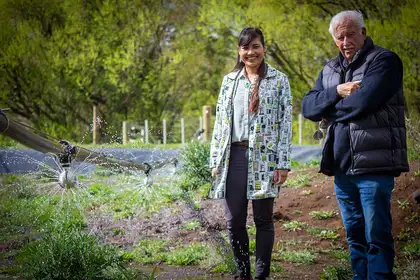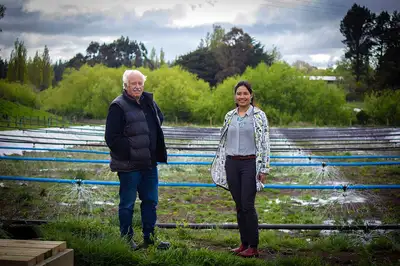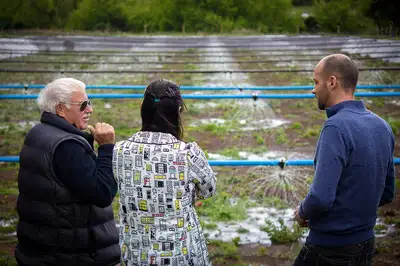
Dr Sasikunya (May) Cheuyglintase graduated with a PhD in Soil Science.
A team of Massey University soil scientists are working with local councils to help remove phosphorus from wastewater using large filters made of soil.
“Councils from around the country employ a range of wastewater treatment systems to get nutrient levels to an acceptable environmental standard before the wastewaters are discharged to waterways. However, dissolved reactive phosphorus (DRP) is one of the more challenging nutrients to remove. Phosphorus finds its way into New Zealand’s sewage treatment plants from human waste, detergents and food residues.
“The release of high levels of DRP into rivers and streams, combined with other nutrients like nitrogen, can result in excessive aquatic weed and algae growth, causing a decline in water quality. Therefore, to improve water quality, councils require more affordable ways of removing DRP from wastewater. However, a method that works for one council may not work well for another, due to differences in a range of factors including town population, the composition of the wastewater, current wastewater infrastructure and the characteristics of the receiving river.”

Dr Cheuyglintase’s PhD research sought to develop a new treatment technology for small to medium sized towns to remove DRP from wastewater more successfully. This involved developing and evaluating the use of soil filters, using specially selected soil with high phosphorus sorbing properties.
“A soil filter is quite a simple yet effective solution for DRP treatment, especially for smaller communities for whom more complex systems can be cost prohibitive. You take wastewater and apply it over the soil surface using sprinklers and a large proportion of the DRP can be removed within a few hours when a soil with the right attributes is used.”
But in order to build these filters, the research had to first identify the optimum soil. In the central North Island, there is an abundance of allophanic soils, which have large capacities for phosphorus sorption, so the research team explored whether these soils could be used as low-cost filter material. Multiple sites were tested and a soil with an especially high phosphorus sorption value was identified.

Dr Cheuyglintase evaluated this soil in the laboratory and then with pilot-scale soil filters aimed at removing DRP from both town and dairy factory wastewaters. The pilot-scale soil filters, each measuring around one metre squared, were setup and operated for more than a year at the Dannevirke wastewater treatment plant and the Fonterra Te Rapa wastewater treatment plant.
Initially, the pilot-scale soil filters were more than 95% efficient at removing DRP from wastewater, but then efficiency declined as the filters become loaded with phosphorus over time. Improvements in filter performance were achieved by acid dosing the alkaline wastewater down to a pH of 5.5, which is more favourable for phosphorus sorption processes. However, another finding of the study was that just using a larger amount of soil may be a less expensive option than acid dosing.
The problem with many phosphorus treatment methods, like chemical dosing, is that they produce waste sludges that typically need disposal in landfills. However, soil filters allow the phosphorus removed from the wastewater to be re-used. Supervisor for this PhD research Dr James Hanly says that “phosphorus is a limited resource, so wastewater treatment systems that provide the opportunity to recycle phosphorus have a real advantage”.
At the completion of the filter experiments, the filter soil was evaluated as a phosphorus source for plant growth. It was added to a phosphorus deficient soil and then used to grow ryegrass under glasshouse conditions. The fertiliser value of the filter material was compared with a soluble phosphorus fertiliser. Results showed that the filter soil was a good source of phosphorus for plant growth and its application to farms has the potential to recycle both the filter soil and the phosphorous it contains.

Based on the results of Dr Cheuyglintase’s research, utilities engineer at Tararua District Council Eric Bonny oversaw the construction of three full-scale soil filters at the Dannevirke, Woodville and Norsewood wastewater treatment plants. The soil filter at Dannevirke covers an area of about 4000 metres squared and is half a metre deep. Extensive work was completed to identify the right locations for the soil filters and find the right kind of sprinklers to achieve adequate wastewater flow rates and distribution across the filter surface.
In order to extend the life of the full-scale soil filters, they will mainly be used when they are most needed, which is typically in summer and autumn when river flow is often low. The use of soil filters at this time of year, along with other treatments, will help to ensure that wastewater discharges meet the river DRP standard. It is hoped that the findings from these soil filters can be applied elsewhere for other similar communities.
Dr Cheuyglintase graduated with a PhD in Soil Science at the November 2019 graduation celebrations in Palmerston North.
The PhD project, Removal of dissolved reactive phosphorus from municipal and dairy factory wastewater using allophanic soils, received funding and support from Fonterra Co-operative, Horizons Regional Council and Taraura District Council. Her supervisors were Dr James Hanly and Associate Professor David Horne.